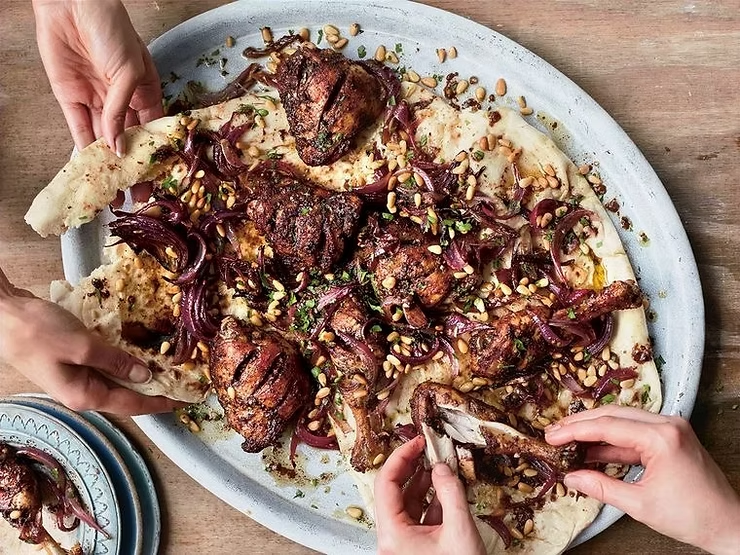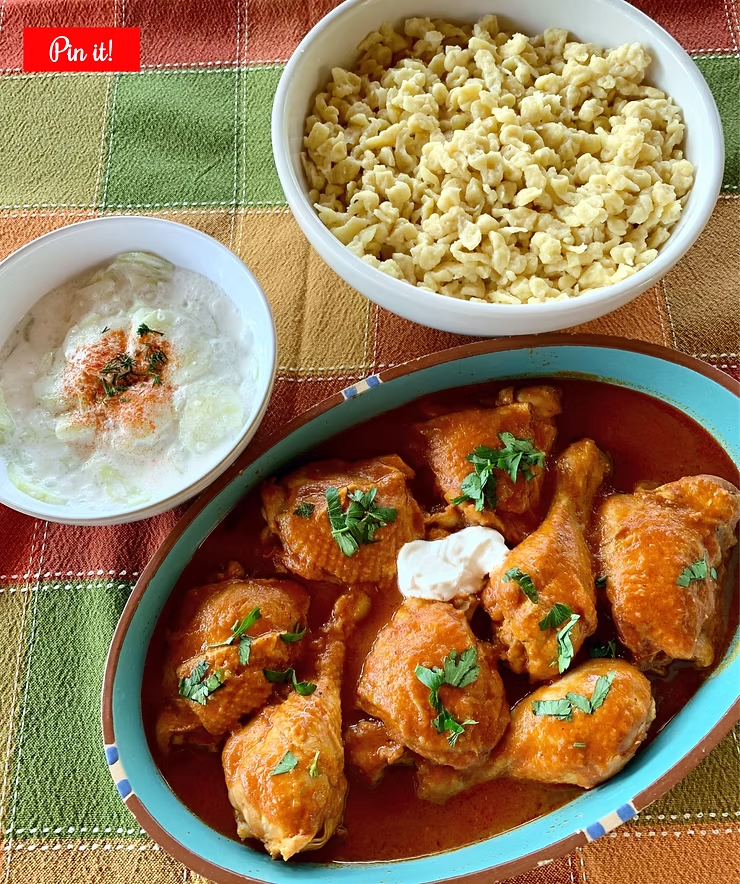In my last post, we caravaned to Petra, Jordan. I now invite you to savor a wonderful Middle Eastern dish, with me. Mussakhan is Palestinean Arab cuisine consisting essentially of roasted chicken heavily scented with tangy sumac and other warm spices, caramelized red onions, and pine nuts served on a delicious flatbread. The dish incorporates other great flavor enhancers, such as cumin, allspice, cinnamon, lemon, and garlic. It is traditionally served over Arabic taboon bread, a serving style that allows all of those delicious roasting juices and flavors to seep into the bread. Taboon bread, also known as Lafah, is a flatbread common in the Levant (Palestine, Israel, Syria, Lebanon, and Jordan). Mussakhan is also popular in the Levant, particularly among Palestinians, Israeli Arabs and Jordanians. When served over taboon, the dish is meant to be a shared meal eaten with your hands. Put the platter with the taboon and meat in the center of the table, simply pull off sections of juicy, flavorful taboon and use it to scoop up the caramelized onions, then eat the tender chicken as it peels away from the bone. If you prefer to skip the flatbread, then the meat dish can also be served with rice … or saffron rice to make it extra yummy! Other side options are chopped Arabic salad, (tomatoes, cucumbers, and parsley with a drizzle of olive oil and lemon juice), tabouleh salad, marinated olives, or some baba ganoush dip. Whichever you choose, I think you will be ‘Wowed!’ by the flavor.
 Spices in the Middle East
Spices in the Middle East
As noted in my Petra post, spices have traversed the Levant for 2000+ years. The desert-master Nabateans monopolized the spice route … to and through Petra, west to Gaza port, north to Palmyra and Damascus, and south to Egypt. It is no surprise that Middle Eastern cooking is scented with many spices. Some originated from the far East, such as Turmeric, Cardamom, and Cinnamon. Others are grown regionally, such as Za’atar, Sumac, and Cumin. Nonetheless, these and several others play heavily in Middle Eastern cuisine.
Sumac: The sumac fruit is dried and ground to produce a tangy, almost lemony, crimson spice. Its use imparts a tart flavor and bold magenta color to the dish. It is a powerful anti-inflammatory and packed with antioxidants. If you don’t have sumac available then the best flavor substitute for it would be lemon pepper.
Cinnamon: This spice comes from the inner bark of an evergreen-type tree, from the genus Cinnamomum, grown primarily in Sri Lanka, Indonesia, and China. It is a very aromatic flavor enhancer, so a little goes a long way. You only need to use a small amount! While we (in the USA) most commonly use cinnamon in desserts and sweets, it is widely used in the Middle East, and in Greece for that matter, as a flavor additive to meats in savory dishes.
Cumin: Cumin seeds are popularly used in both whole and ground forms. Its seeds have been excavated in Syria dating to 2000 BC. It was also a significant spice used by the Minoans in Crete (~2000-1500 BC) and Egyptians during the New Kingdom (~1500-1000 BC.) Needless to say, Cumin has a rather long history! It imparts an earthy, warm, and aromatic character to food.
Pine Nuts: These are edible seeds of pines prominently consumed in Middle Eastern cuisine, although it has widespread geographical consumption. In the Middle East, they are commonly added to a range of dishes like kibbeh, hummus, roasted meats, samosas, meat pies, or desserts like Baklava.
 Recipe for Mussakhan
Recipe for Mussakhan
Ingredients:
2 – 2.5 lbs chicken thighs and drumsticks, skin on
3 Tbsp extra virgin olive oil, plus a little extra to serve
1/2 tsp ground cumin
1/2 tsp ground allspice
1/4 tsp ground cinnamon
1 1/2 Tbsp sumac, plus more to dust
Juice of 1 lemon
4 cloves of garlic, pressed
1 1/2 tsp Sea salt
1/2 tsp freshly ground black pepper
2-3 large onions (about 1 lb), thinly sliced
3 Tbsp pine nuts
1 Tbsp olive oil
Arabic taboon bread, to serve
Parsley leaves, chopped
Instructions:
Slash the flesh of each piece of chicken diagonally in several places, spacing the slashes about 3/4 inch apart, and then place the meat in a large bowl.
Combine a mixture of the extra virgin olive oil, spices, lemon juice, garlic, salt, and ground black pepper. Pour mixture over the meat and rub into the meat. Add the red onions and toss everything together well. Cover with plastic wrap and let marinate for 3 hours (or longer).
When ready to roast the chicken, pre-heat the oven to 400 F.
Transfer the meat and onions to a baking pan and roast for 1 hour, or until the chicken juices run clear when pierced at their thickest part. After an hour of roasting, I broil on high for about 3 minutes to give it a nice color. Once the chicken is cooked remove from oven, cover with foil and leave to rest while you prepare the toppings.
Fry the pine nuts in the one Tbsp of olive oil for a minute or so, until they turn golden brown. Remove nuts from oil and drain them onto a paper towel.
To serve, warm the taboon bread briefly in the oven. Remove and place the bread onto a platter. Then place the chicken and caramelized red onions on top of the bread. Finish with a scattering of pine nuts and chopped parsley. Dust with a bit of sumac. Drizzle the top with any remaining roasting juices so they soak into the bread. You can then drizzle with a bit more olive oil if desired.
Cooking Tips
Mussakhan is not difficult to make, but it does have several steps. This dish is hearty and full of flavor. It should be very ‘oniony’ and dripping with juices and olive oil. For best results, make sure to lift the chicken skin and apply some of the spice mixture underneath. Also, don’t skimp on the lemon juice, as that brings the dish to life. The longer you marinate, the more the flavor… so don’t skimp, either, on the 3-hour marinating time. The sumac, however, is the star flavor-maker and gives the dish a beautiful magenta color. If you don’t have access to sumac, then you can substitute lemon pepper for a similar flavor. If you are unsure of the chicken’s “doneness”, then use an Insta-read kitchen thermometer and pull when the chicken, at its thickest part, is 165 F. If you use boneless chicken, then it will cook faster. If you don’t have an Arabic store nearby that sells taboon bread, then you can substitute Greek pita bread or Indian Naan.
This sumac chicken with caramelized onions on a warm flatbread is gratifying comfort food and the fragrant scent, while roasting, will surely whet your appetite. Whenever I make this dish, the taste and the aroma immediately transport me back to Jerusalem’s Old City, the West Bank, and Jordan. The Levant is steeped in millenniums of history and that richness is reflected in this dish. I hope you give it a try!
This recipe is from Zaitoun: Recipes from a Palestinian Kitchen, by Yasmin Khan. 2018.





